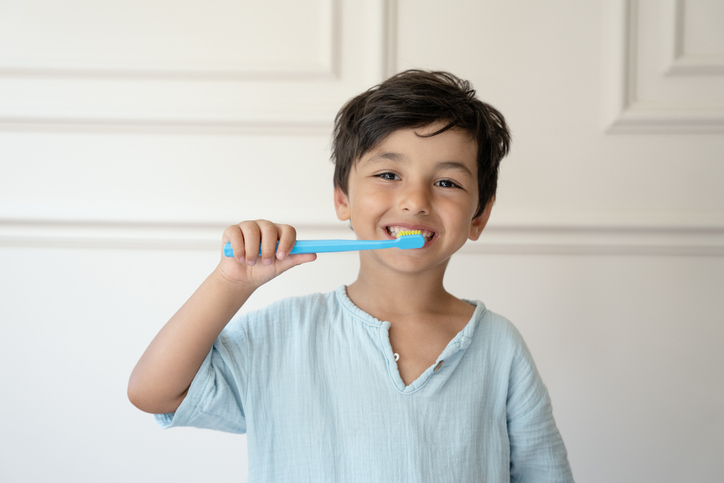As a parent, you want to give your child the best start when it comes to their oral health. One of the easiest and most impactful ways to do that is by choosing the right toothbrush. At ICTeeth Pediatric Dentistry, with convenient locations in Wichita and our Derby sister practice, Smile Safari Pediatric Dentistry, we understand that walking down the dental care aisle can be overwhelming. Here’s what you need to know to make the right choice for your little one.
1. Choose the Right Size
Toothbrushes come in many shapes and sizes. For children, a brush with a smaller head fits better in their mouth and makes it easier to reach all tooth surfaces. Look for toothbrushes labeled by age range, such as “Ages 0-2,” “2-4,” or “5-7.” These are designed with your child’s specific needs in mind. A smaller toothbrush allows for better maneuverability, especially in hard-to-reach areas like the back molars.
For babies and toddlers, a toothbrush with an oversized handle and a small, cushioned head is ideal. As children grow and develop better motor skills, toothbrushes with slimmer, ergonomically designed handles help them learn proper brushing techniques.
2. Soft Bristles Are a Must
Always choose a toothbrush with soft or extra-soft bristles. Kids’ gums and enamel are sensitive, and soft bristles clean effectively without causing damage. Hard bristles can wear down enamel and irritate delicate gums, especially for children still learning proper technique.
In fact, soft bristles are more than just a comfort choice—they’re a safety feature. They gently massage the gums and clean around the gum line without causing trauma. Children who experience discomfort during brushing are less likely to develop consistent oral hygiene habits, so keeping brushing pain-free is crucial.
3. Manual vs. Electric Toothbrushes
Both types can be effective when used correctly, but electric toothbrushes can offer some advantages:
- Built-in timers to encourage brushing for a full two minutes
- Rotating heads that make brushing easier
- Fun designs and sounds that can motivate reluctant brushers
Electric toothbrushes can be especially helpful for children with braces or those who struggle with coordination. The vibration and rotation of electric models help remove plaque more efficiently and can make brushing feel less like a chore.
That said, a good manual toothbrush can work just as well, especially if your child enjoys using it. The most important factor is not the type of brush but whether it is being used properly and regularly.
4. Fun Designs Make a Difference
Toothbrushes featuring your child’s favorite cartoon characters or bright colors can turn brushing into a fun activity rather than a chore. Let your child pick out their toothbrush to make them feel more involved and excited about oral hygiene.
When children are emotionally engaged, they are more likely to follow through with brushing. This element of personal choice helps build a positive relationship with oral care. Some brushes even play music or light up, adding an extra layer of fun to the daily routine.
Creating a reward system or brushing chart can also encourage consistency. Brushing together as a family can help model good habits while making it a shared, enjoyable experience.
5. Look for ADA Approval
The American Dental Association (ADA) Seal of Acceptance ensures that a toothbrush has been tested for safety and effectiveness. It’s a simple way to know you’re choosing a quality product.
To earn this seal, a toothbrush must meet strict standards for performance, bristle quality, and durability. Choosing an ADA-approved brush means you can trust that the product is both safe and effective for your child.
6. Replace Regularly
Children’s toothbrushes should be replaced every 3 months, or sooner if the bristles are frayed. Also replace the toothbrush after your child has been sick to avoid reintroducing germs.
Frayed bristles are less effective at removing plaque and can irritate the gums. If you’re unsure whether it’s time to switch, look at the condition of the brush head. If the bristles are bent or discolored, it’s time for a new one.
It’s also a good idea to keep a few spare toothbrushes at home. This way, if your child loses one or if you notice wear and tear suddenly, you won’t miss a beat in their oral care routine.
7. Don’t Forget Toothbrush Storage
Proper toothbrush storage is often overlooked but plays a key role in hygiene. Store your child’s toothbrush in an upright position, and allow it to air dry. Avoid placing it in a closed container where bacteria can thrive.
Make sure toothbrushes used by different family members do not touch, especially during flu season. Using a toothbrush holder with separate slots or compartments can help maintain cleanliness.
When in Doubt, Ask Your Pediatric Dentist
At ICTeeth Pediatric Dentistry, we’re always happy to help you make the best choices for your child’s oral health. During your child’s next visit, feel free to ask us about toothbrush recommendations specific to their age and dental needs.
We also offer personalized dental education during each appointment, so your child learns how to brush effectively and confidently. Building these habits early can set the foundation for a lifetime of healthy smiles.
Schedule your child’s next appointment today and give them the tools for a lifetime of healthy smiles!

